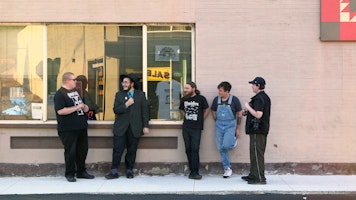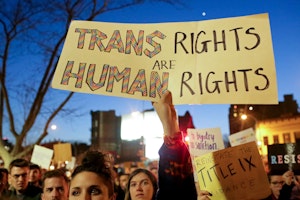The Deep Roots of the U.S. Ban on Trans Soldiers
By Karen Stevenson

President Trump’s recent tweets expressing his intention to ban transgender people from serving in the U.S. military whipped the media into a frenzy, occasioned an implicit rebuke from the chairman of the U.S. Joint Chiefs of Staff, and reignited an already intense public debate about the rights and safety of transgender people.
As notable as Trump’s tweets were, however, they did not come out of nowhere. On the contrary, they reflect a broader political and cultural context—one in which transphobic sentiments and actions are often not only encouraged, but rewarded.
In our Capturing Hate report, for example, we at WITNESS delved into the world of transphobic online videos, which document hideous acts of physical and psychological violence against trans people: assaults, threats, intimidation, harassment, stalking, bullying, even murder. These videos were not made with the intention of exposing or prosecuting abuse; they were posted—and are widely shared—as a sadistic form of entertainment.
While our goal was to find out whether perpetrator videos such as these could be safely and ethically used as a tool for the advancement of trans people’s rights, we found that a single derogatory search term led to hateful videos on YouTube, Facebook, Twitter, and other social media platforms. Not infrequently, these videos are surrounded by advertisements from some of the world’s largest and wealthiest corporations, such as Walmart, Applebee’s, Heineken, and the New York Times.
In our analysis, we looked at a relatively small number of these videos, focusing on those that depicted acts of physical violence. What we found was profoundly disturbing. From these mere 329 videos, we documented more than 89 million views, more than 600,000 shares, and more than 500,000 “likes.” Nearly as shocking as their popularity and volume were the videos’ longevity: some were posted more than a decade ago, yet are still being seen, shared, and commented on by large numbers of people.
Worse still, these social biases are compounded by institutional ones. Indeed, it is likely that a larger cultural shift toward understanding and addressing the needs of trans and gender-nonconforming communities has been hampered by a lack of reliable data on the violence perpetrated against them.
A report released in 2016 by the National Center for Transgender Equality called this lack of information “one of the greatest policy failures facing the trans movement today” [PDF] and the FBI has admitted that its data on hate attacks underreports those inflicted on LGBTI people because of its dependence on self-reporting by local law enforcement. The Trump administration’s decision to exclude questions of sexual orientation and gender identity from the next census will continue to obscure institutional bias and the staggering amount of anti-transgender violence.
These videos exist to amuse and disparage. Unintentionally they also provide information that is otherwise lacking. In an irrefutable way, they expose the pervasiveness of transphobic attitudes and the intersection of online exchange with real world acts.
The titles, descriptions, and comments describing these videos reveal vehement attachment to gender expression as binary. Any transgression—including physical features, mannerism, and dress—is met with open hostility and incitements to violence.
Curating, studying, and analyzing these videos is a powerful way to expose transphobia, but navigating the tensions between revictimization and exploitation on the one hand, and the potent way video exposes abuse on the other, is an ongoing challenge. Unprecedented access to cameras and streaming platforms, and the ability to capture and share content, has led us into uncharted territories.
We all grapple with how to sort the deluge that is often unleashed without consideration and tell stories in a way that clarifies rather than confuses, protects the privacy of victims, and empowers rather than depresses our audiences. Our work here at WITNESS is dedicated to finding innovative, safe, and ethical ways to use eyewitness video for human rights.
Finally, it should not be forgotten that long before the 2016 election, many social conservatives had already made discrimination against trans and gender-nonconforming people a central element of their political program. Similarly, in a majority of U.S. states, it is still legal to exclude trans people from public accommodation, employment, housing, and health care. The president’s tweets are symptomatic of a culture in which hate for trans and gender-nonconforming people is still accepted.
And as Capturing Hate shows, the problem confronting those who support the human rights of trans and gender-nonconforming people is far bigger than President Trump.
WITNESS is a grantee of the Open Society Foundations.
Karen Stevenson is the program manager of the WITNESS Media Lab.


